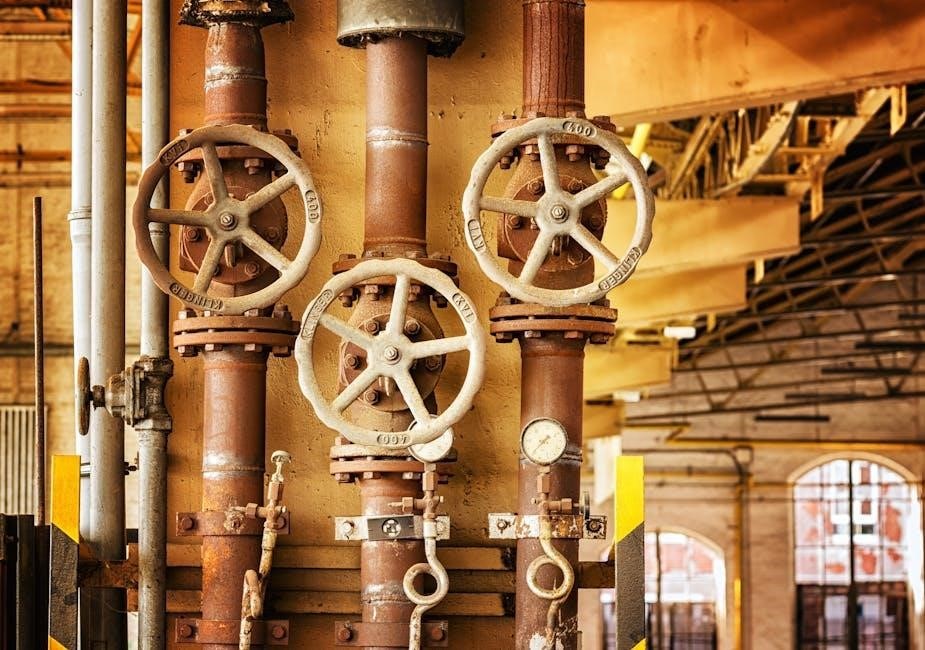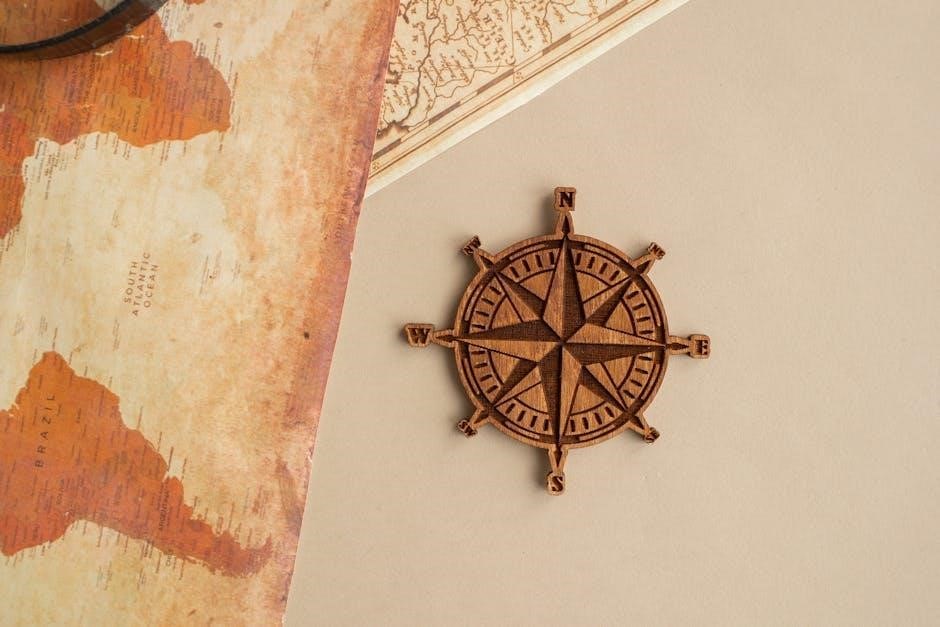Valve guide reamers are precision tools used to accurately size valve guide holes in engines. Essential for ensuring proper fit and concentricity, they enhance engine performance and longevity.

Types of Valve Guide Reamers
Valve guide reamers are available in HSS, carbide, and solid carbide types, each offering unique durability and precision for specific materials like bronze or cast iron guides.
2.1. HSS (High-Speed Steel) Valve Guide Reamers
HSS valve guide reamers are durable and cost-effective tools. Manufactured from high-speed steel, they are suitable for reaming valve guides in various applications, including automotive and small engines. Available in spiral flute designs, they provide efficient cutting action, reducing chatter and vibration during operation. These reamers are often preferred for their balance of affordability and performance. They are widely used in workshops and are available in sets covering multiple sizes, making them versatile for different projects. Proper use with coolant or lubrication, such as Windex glass cleaner in some cases, ensures optimal results and tool longevity. HSS reamers are a reliable choice for many mechanics and technicians.
2.2. Carbide Valve Guide Reamers
Carbide valve guide reamers are highly durable and designed for demanding applications. Made from tungsten carbide, they offer exceptional hardness and resistance to wear, making them ideal for reaming tough materials like cast iron or bronze valve guides. These reamers are commonly used in aircraft engines and high-performance automotive applications where precision and longevity are critical. Carbide reamers maintain sharpness and cutting efficiency over extended use, reducing the need for frequent replacements. They are more expensive than HSS reamers but provide superior performance in challenging environments. Proper storage and maintenance are essential to preserve their cutting edge and ensure consistent results.
2.3. Solid Carbide Valve Guide Reamers
Solid carbide valve guide reamers are premium tools crafted entirely from tungsten carbide, offering unparalleled hardness and resistance to wear. Unlike carbide-tipped reamers, solid carbide reamers are made from a single piece of material, ensuring consistent performance and longevity. They excel in high-precision applications, such as reaming valve guides in aerospace and racing engines, where tight tolerances are critical. Solid carbide reamers are more expensive but provide superior durability, maintaining their cutting edge even in tough materials. They are less prone to chipping and deliver smoother finishes, making them a preferred choice for professionals requiring reliable and precise results in demanding environments.

Materials for Valve Guides
Valve guides are typically made from durable materials like bronze, cast iron, or steel alloys, chosen for their strength, heat resistance, and ability to withstand engine wear.
3.1. Bronze Valve Guides
Bronze valve guides are a popular choice due to their exceptional durability and thermal resistance. Made from a copper-tin alloy, bronze offers excellent wear resistance and can withstand high engine temperatures. Its natural lubricity reduces friction between the valve stem and guide, enhancing engine performance. Bronze guides are often preferred in high-performance engines because they maintain dimensional stability under stress. They also provide a balance between hardness and flexibility, making them suitable for various engine applications. Properly installed bronze valve guides ensure consistent valve alignment, preventing overheating and extending the lifespan of engine components. Their reliability and compatibility with reaming tools make them a favorite among engine builders and mechanics;
3.2. Cast Iron Valve Guides
Cast iron valve guides are widely used for their excellent heat dissipation properties and durability. They are often preferred in engines where cost-effectiveness and simplicity are prioritized. Cast iron guides provide a rigid structure that resists wear and tear, making them suitable for budget-friendly engine applications. Their thermal conductivity helps maintain consistent engine temperatures, reducing the risk of overheating. However, they are heavier and less corrosion-resistant compared to bronze guides. Despite this, cast iron valve guides remain a reliable choice for many automotive and industrial engines due to their affordability and robust performance. Regular maintenance ensures their longevity and optimal functionality in various engine environments.
Applications of Valve Guide Reamers
Valve guide reamers are essential in engine repair, used in automotive and aerospace industries to restore valve guides, ensuring proper fitment and engine performance. They ensure precision, durability, and optimal engine operation by maintaining accurate valve stem-to-guide clearances.
4.1. Aircraft Engine Valve Guides
In aircraft engines, precision and durability are critical due to the high-stress operating conditions. Valve guide reamers play a vital role in maintaining engine performance by ensuring proper valve stem-to-guide clearance. This is essential for preventing excessive oil consumption, reducing emissions, and maintaining optimal combustion efficiency. Aircraft engines often use high-strength materials like bronze or steel for valve guides, which require precise reaming to achieve the exact tolerances needed for smooth operation. Reaming in aviation applications must adhere to strict standards to ensure reliability and safety. The process involves restoring worn or damaged valve guides to their original specifications, ensuring consistent engine performance and longevity. Proper reaming is crucial for maintaining the integrity of aircraft engines under demanding conditions.
4.2. Automotive Engine Valve Guides
In automotive engines, valve guide reamers are essential for maintaining proper valve stem-to-guide clearance, ensuring efficient combustion and preventing oil leakage. Reaming is often required during engine overhauls to repair worn or damaged valve guides, which can cause poor engine performance and increased emissions. Automotive valve guides are typically made from materials like cast iron or bronze, which must be reamed to precise specifications. The process involves removing minimal material to restore the guide to its original diameter, ensuring proper valve sealing and operation. Using the correct reamer size and type is crucial to avoid further damage and ensure optimal engine functionality. Regular maintenance with valve guide reamers helps extend engine life and improve overall efficiency.

Tools and Equipment Needed for Reaming
Essential tools include a high-precision drill press, valve guide reamers, cutting oil, gauges, and alignment fixtures to ensure accurate and efficient reaming operations.
5.1. Drill Press for Reaming
A drill press is indispensable for reaming, offering stability and precision. Its variable speed control ensures consistent reaming, while a rigid design minimizes vibration. Proper mounting and alignment are crucial for accurate results. Using the correct drill press setup prevents damage to both the tool and workpiece, ensuring smooth operation. Safety measures, like securing the workpiece and using appropriate fixtures, are essential to avoid accidents during the process.
5.2. Coolant and Lubrication
Coolant and lubrication are essential for efficient and precise reaming. Coolant reduces heat generated during the process, preventing damage to both the reamer and the valve guide. Lubrication minimizes friction, allowing smoother operation and protecting the tool from wear. Using the right coolant, such as water-based or synthetic oil, ensures optimal cooling. Proper application methods, like flood cooling or misting, maintain consistent temperatures. Neglecting coolant and lubrication can lead to overheating, tool damage, and inaccurate results. Regular maintenance and application of these fluids are crucial for extending tool life and ensuring high-quality reaming outcomes.

Troubleshooting Common Issues
Troubleshooting common issues with valve guide reamers involves diagnosing misalignment, excessive wear, or inconsistent results. Regular inspection and tool calibration can prevent these problems, ensuring precise outcomes.
6.1. Inconsistent Reaming Results
Inconsistent reaming results can stem from improper tool alignment, worn-out reamer bits, or uneven material hardness. Misaligned tools often lead to non-concentric holes, while dull cutters cause uneven surface finishes. Additionally, incorrect spindle speed or feed rates can exacerbate these issues, resulting in variability in the final diameter. To address this, ensure proper setup, use precision guides, and maintain sharp cutting edges. Regular tool inspection and calibration are crucial to prevent such inconsistencies. Proper coolant application and maintaining consistent material temperatures also play a role in achieving uniform results. Addressing these factors ensures reliable and precise valve guide reaming outcomes.
6.2. Reamer Wear and Tear
Reamer wear and tear is a common issue that can arise from excessive use, improper maintenance, or operating on hard materials without adequate lubrication. Signs of wear include dulled cutting edges, uneven surfaces, and reduced precision in the reamed holes. Prolonged exposure to high temperatures or abrasive materials can accelerate wear. Regular inspection and sharpening of the reamer are essential to maintain performance. Using the correct coolant and avoiding excessive force can minimize wear. Neglecting maintenance can lead to premature tool failure, requiring costly replacements. Proper storage and handling also contribute to extending the lifespan of valve guide reamers, ensuring consistent and reliable results in engine repair applications.

The Reaming Process
The reaming process involves rotating a reamer to enlarge and finish valve guide holes, ensuring precise dimensions and smooth surfaces for optimal engine performance and durability.
7.1. Manual Reaming vs. Machine Reaming
Manual reaming involves handheld tools, offering precision and control, ideal for small-scale or intricate valve guide repairs. Machine reaming uses automated equipment, ensuring consistency and efficiency, especially in high-volume production. Manual methods are cost-effective for minor adjustments, while machine reaming delivers faster results with minimal human error. Both techniques require skill to achieve accurate dimensions and smooth finishes. The choice depends on the project’s scale, available tools, and desired output quality. Proper training is essential for both methods to avoid damage to valve guides or surrounding materials.
7.2. Importance of Concentricity
Concentricity is crucial in valve guide reaming to ensure the valve stem and guide align perfectly. Misalignment can lead to uneven wear, reduced engine performance, and increased emissions. Proper concentricity maintains optimal airflow, prevents premature wear on moving parts, and ensures efficient combustion. Achieving precise alignment requires careful measurement and skilled operation of reaming tools. Advanced equipment often includes features to maintain concentricity, while manual methods rely on operator expertise. Regular inspection and adjustment are essential to uphold this critical parameter, ensuring long-term engine reliability and performance. Neglecting concentricity can result in costly repairs and compromised engine functionality.
7.3. Final Honing After Reaming
Final honing after reaming is essential for achieving the desired surface finish and dimensional accuracy in valve guides. Honing removes minor imperfections left by reaming, ensuring a smooth, even surface for optimal valve stem operation. This process involves using a honing stone or tool to polish the guide bore, improving lubrication and reducing wear. Proper honing techniques prevent overheating or damage to the guide material. The result is a precise, rounded finish that enhances engine performance and longevity. Honing is a critical step, as it ensures the valve guide meets specifications for fitment and functionality, directly impacting engine efficiency and reliability over time.

Maintenance and Longevity of Valve Guides
Regular maintenance ensures valve guides last longer and perform efficiently. Cleaning, inspecting, and replacing worn guides prevent engine damage and maintain optimal performance over time.
8.1. Regular Inspection
Regular inspection of valve guides is crucial to ensure proper engine performance and longevity. Inspect guides every 100 hours for aircraft engines or 50,000 miles for automotive use. Use a dial bore gauge to measure guide clearance, ensuring it aligns with manufacturer specifications. Visually check for excessive wear, scoring, or discoloration. If clearance exceeds limits or damage is evident, replace the guide immediately. Neglecting inspections can lead to increased oil consumption, reduced compression, and potential engine damage. Always compare measurements with original specifications to maintain precise tolerances. Early detection of wear prevents costly repairs and ensures smooth engine operation. Regular inspections are a cornerstone of proactive maintenance.
8.2. Cleaning and Honing
Cleaning and honing are essential steps to maintain the precision and longevity of valve guides. After reaming, residual debris and metal shavings must be thoroughly removed using compressed air or solvent-based cleaners. Honing involves lightly polishing the guide surface to achieve a smooth finish, ensuring proper lubrication and even wear. This process also corrects minor surface irregularities without altering critical dimensions; Use specialized honing tools or flexible hones designed for valve guides. Always apply a suitable lubricant during honing to prevent overheating. Regular cleaning and honing help maintain tight tolerances, reduce friction, and prevent premature wear. These practices are vital for optimizing engine performance and extending the service life of valve guides. Consistency in these maintenance routines ensures reliability and efficiency in engine operation.

Safety Precautions While Using Reamers
Always wear safety glasses and gloves. Ensure proper workpiece securement to prevent movement. Maintain a clean workspace to avoid accidents. Follow manufacturer guidelines for tool usage.
9.1. Proper Handling
Proper handling of valve guide reamers is crucial to ensure safety and tool longevity. Always use both hands to maintain control, especially during operation. Avoid applying excessive pressure, as this can cause the reamer to slip or break. Ensure the workpiece is securely held in a vice or fixture to prevent movement. Regularly inspect the reamer for signs of wear or damage before use. Never touch the cutting edges with bare hands, as they are extremely sharp. Use a rag or gloves to handle the tool. Store reamers in a dry, protected area to prevent rust or damage. Proper handling reduces the risk of accidents and ensures precise results. Always follow the manufacturer’s guidelines for handling and usage.
9.2. Safety Gear
Safety gear is essential when working with valve guide reamers to protect against potential hazards. Always wear safety glasses or goggles to shield your eyes from metal shavings or debris. Gloves are critical to prevent cuts and improve grip while handling sharp tools. A face mask is recommended to avoid inhaling dust or particles during the reaming process. Hearing protection may also be necessary if operating loud machinery. Steel-toe boots and protective aprons can further safeguard against accidental injuries. Ensuring proper safety gear minimizes risks and ensures a safe working environment. Always prioritize personal protective equipment (PPE) before starting any reaming operation.
Manufacturer Spotlight
Renowned manufacturers specialize in producing high-quality valve guide reamers, ensuring precision and durability. Their expertise and innovative designs set industry standards, catering to various engine repair needs effectively.
10.1. KPMI Valve Guide Reamers
KPMI is a leading manufacturer of high-quality valve guide reamers, known for their precision and durability. Specializing in tools for the aerospace industry, KPMI reamers are designed to meet strict aviation standards. Their products are crafted from premium materials, ensuring optimal performance in demanding environments. With a focus on innovation, KPMI offers reamers that minimize wear and tear, providing consistent results. Their tools are widely used in aircraft engine maintenance, where accuracy and reliability are critical. KPMI’s commitment to excellence has made them a trusted name among engine repair professionals, ensuring superior outcomes in valve guide reaming operations.
10.2. McFarlane Aviation Valve Guide Reamers
McFarlane Aviation is renowned for producing high-quality valve guide reamers tailored for the aviation industry. Their tools are engineered to meet the precise demands of aircraft engine maintenance. McFarlane reamers are constructed from durable materials like high-speed steel and carbide, ensuring longevity and resistance to wear. They offer a wide range of sizes to accommodate various engine types, making them versatile for different applications. Known for their precision, McFarlane reamers are trusted by aviation professionals for accurate and reliable results. Their commitment to quality and innovation has solidified their reputation as a leading supplier in the aviation sector, providing essential tools for engine overhaul and maintenance.

Choosing the Right Valve Guide Reamer
Selecting the correct valve guide reamer ensures precise engine repairs. Consider material compatibility, size, and application to maintain optimal performance and prevent engine damage.
11.1. Size and Fit
Accurate sizing is crucial when selecting a valve guide reamer. The tool must match the valve guide’s inner diameter precisely to ensure proper installation and function. Incorrect sizing can lead to improper alignment, uneven wear, or even engine damage. Always measure the valve guide carefully before choosing a reamer. A reamer that is too small may not achieve the desired result, while one that is too large can over-ream the guide, compromising its integrity. Proper fit ensures optimal performance and prevents costly repairs. Testing the reamer’s fit in the guide before use is essential to avoid mishaps during the reaming process.
11.2. Material Compatibility
Material compatibility is a critical factor when selecting a valve guide reamer. The reamer must be suitable for the material of the valve guide to ensure proper reaming and prevent damage. For example, bronze valve guides may require reamers with carbide tips to handle their hardness, while cast iron guides might work well with high-speed steel (HSS) reamers. Using the wrong material can lead to premature wear on the reamer or the guide itself. It’s essential to match the reamer’s material properties to the valve guide’s material for optimal performance and longevity. Always consult manufacturer guidelines to ensure compatibility and avoid costly repairs or rework.

Correct Usage of Valve Guide Reamers
Proper installation, alignment, and operation are essential for correct usage of valve guide reamers. Using the right technique ensures efficiency and safety. Always follow manufacturer guidelines for optimal results.
12.1. Driving the Reamer
Driving the reamer requires precision and control to ensure proper alignment and avoid damage. Use a drill press or equivalent machine for stability. Apply steady, consistent pressure while maintaining the tool’s axis alignment with the guide hole. Avoid excessive force, as it may cause deflection or breakage. Utilize coolant or lubrication to reduce friction and prevent overheating. Ensure the reamer is securely attached to the driving mechanism to maintain concentricity. Proper driving technique is critical for achieving accurate and consistent results in valve guide reaming operations. Always follow the manufacturer’s recommendations for speed and feed rates to optimize performance and extend tool life.
12.2. Measuring Valve Stem Diameter
Measuring the valve stem diameter is a critical step to ensure proper fitment and functionality. Use a precision micrometer to accurately measure the stem’s diameter, as even minor deviations can affect performance. Compare the measurement with the valve guide’s inner diameter to confirm compatibility. Proper alignment and sizing are essential to prevent excessive clearance or tight fits, which can lead to wear or failure. Always measure at multiple points along the stem to ensure consistency and detect any taper or irregularities. Accurate measurement ensures the correct reamer size is selected, optimizing the reaming process and extending the lifespan of the valve guide and engine components.
